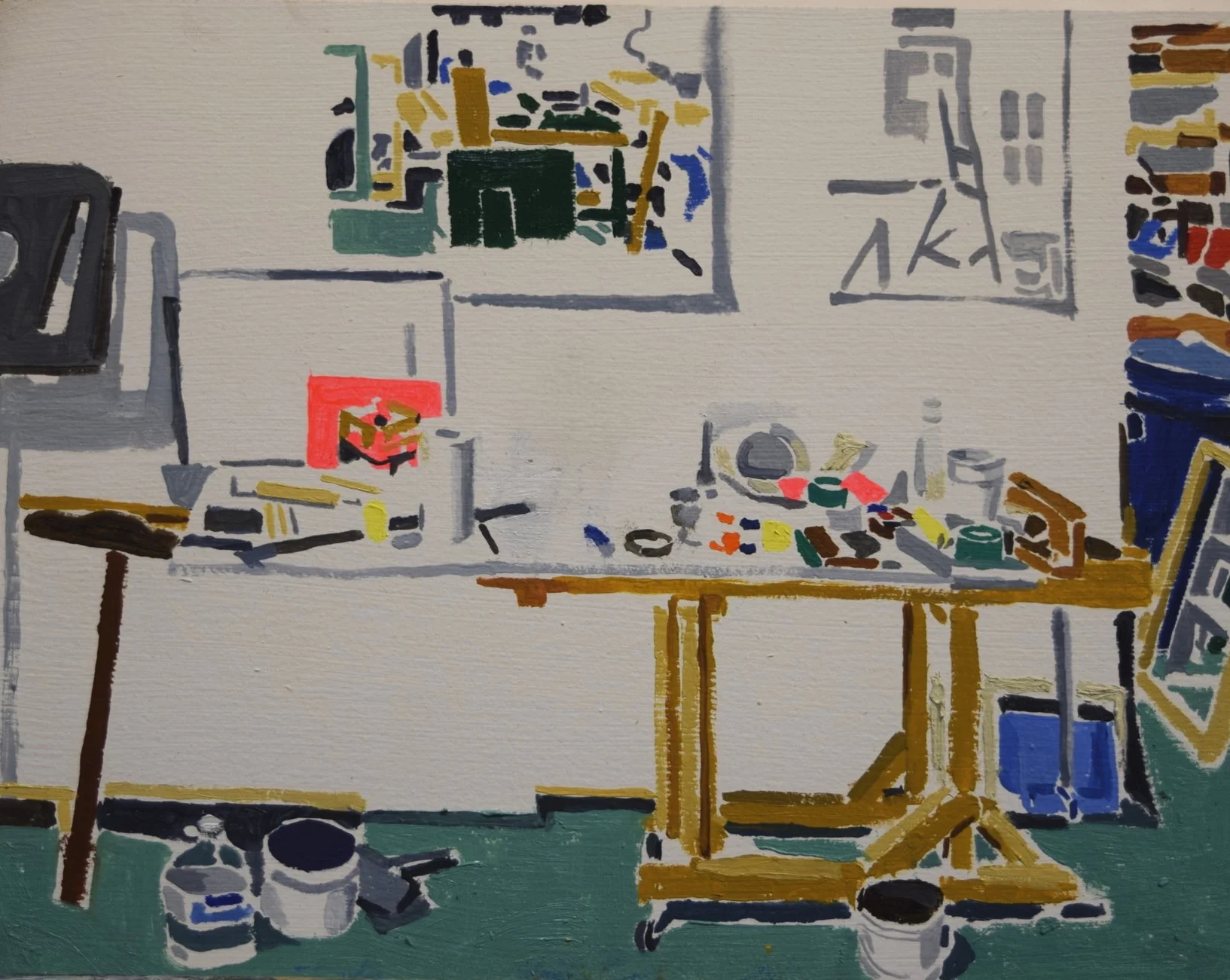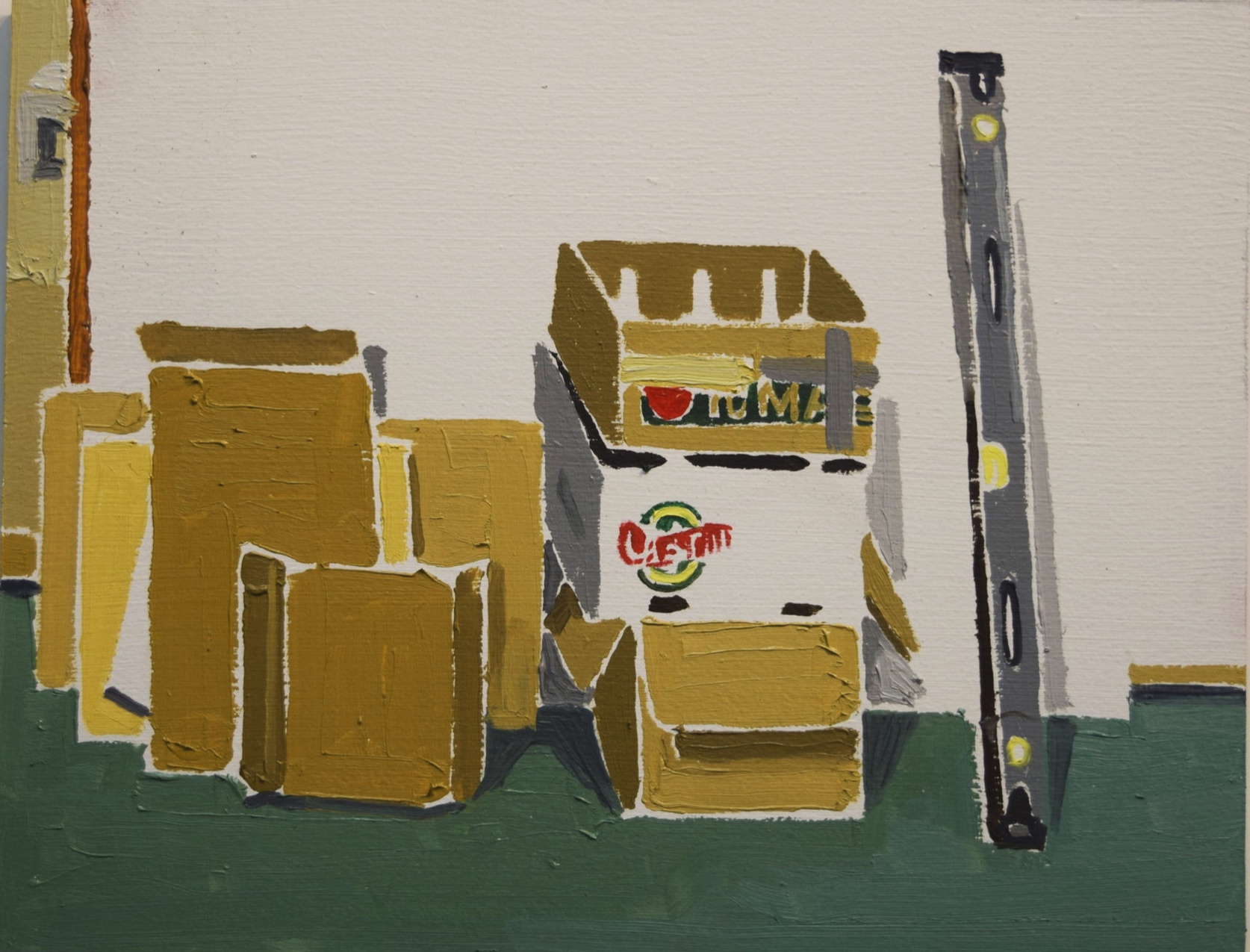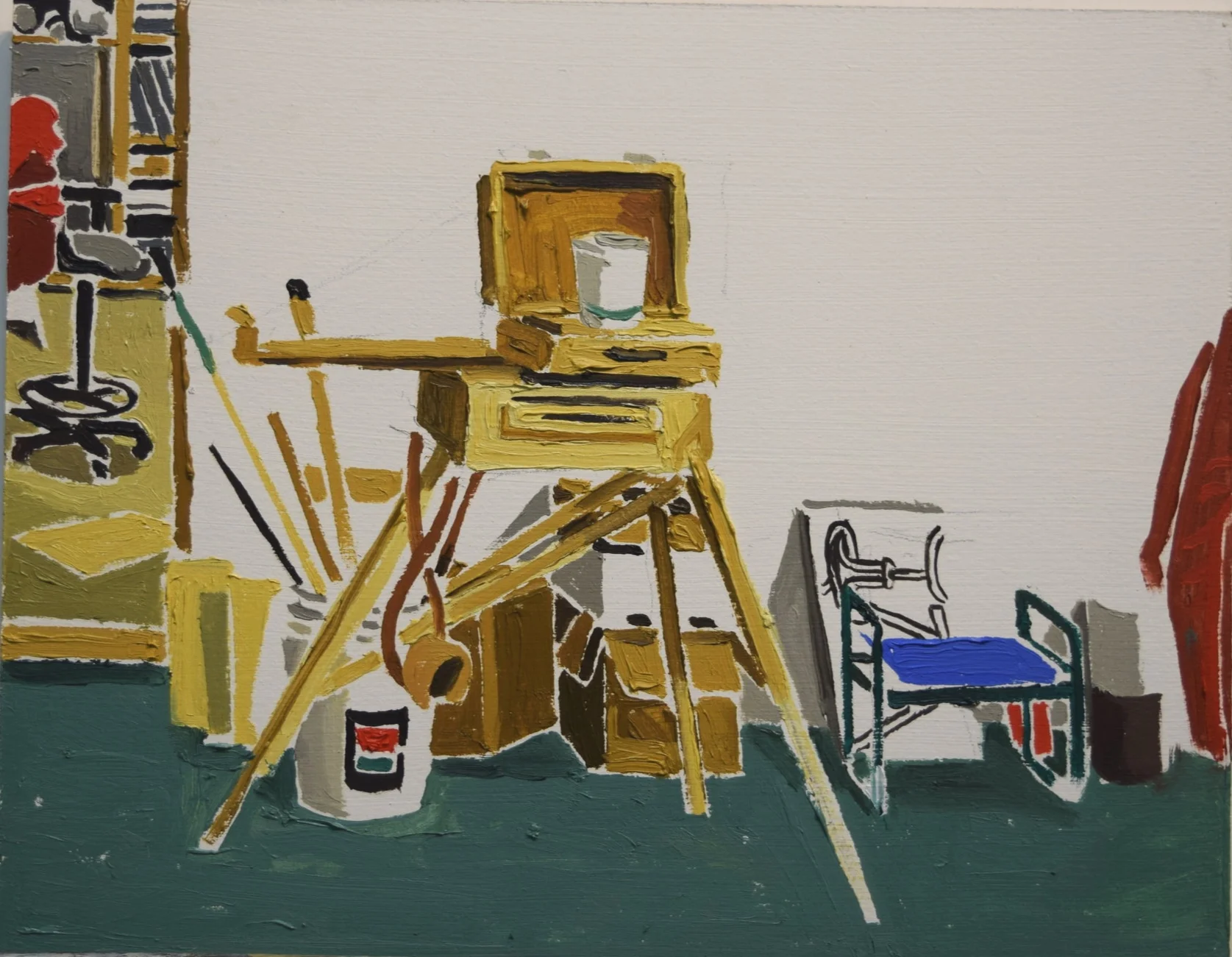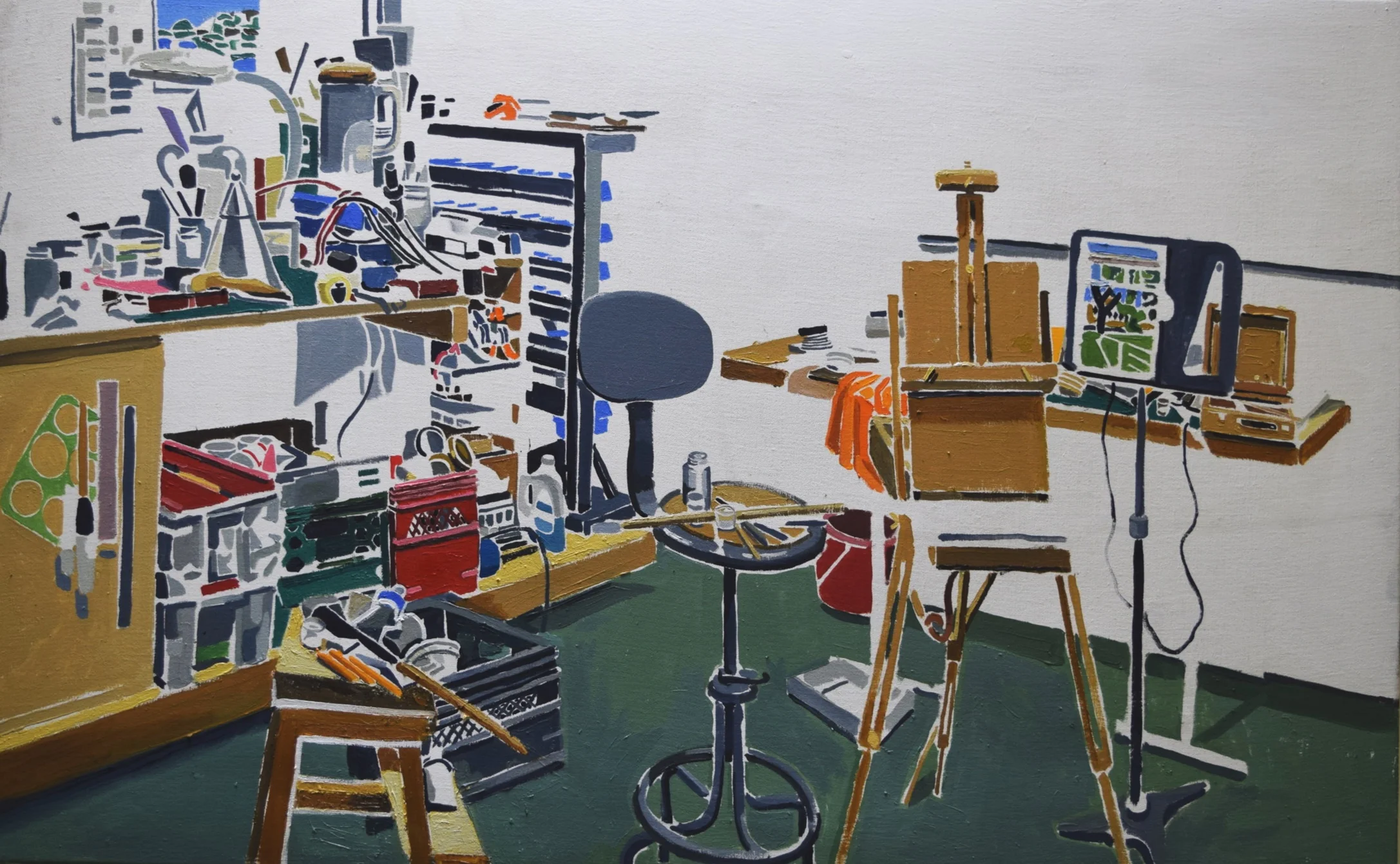






















Michael Merrill: “Studio”
28 avril au 26 mai 2018
A garage, 45’ × 25’×10’, there is a 1964 Ford Thunderbird being restored in the corner. The walls are brick and the floor is cement tilted toward the drain. The ceiling has been insulated and drywalled, but water has infiltrated the roof and some of the drywall has collapsed. There is a table with chocolate bar wrappers on it and an empty coke can. There is a red engine hoist, tools and some dirty rags. This is the first time I see my studio.
I spend six months insulating, drywalling, painting, installing skylights and a proper door. I start working. I have been working here for the last 15 years.
Robert Smithson invoked Cézanne directly when describing the necessity of moving out of the studio and into the world to make his site-specific land art. “We now have to reintroduce a kind of physicality,” he insisted in an interview, “the actual place rather than the tendency to decoration which is a studio thing.”
In 2012 I visit Spiral Jetty, Sun Tunnels, Double Negative, The Lightning Field and Marfa, Texas. I attempt to paint each of these sites in situ. It is impossible. Over the next four years I struggle with questions related to the experience of these works. The removal of a frame is profound. I am no longer looking through a lens, I am surrounded. I become more interested in working from life with the negotiation of reality: flux, wind, bugs, rain, sun, cold, etc. The experience necessitates an efficient and economical form of shorthand that replaces polish with rawness to convey this experience. The work becomes more material oriented. Each mark is a step into thin air. What is unstated becomes as important as what is.
I approach my environment with the same spirit. I paint the studio as a subject, initially as an exercise for plein-air painting. But I have inadvertently taken Robert Smithson’s statement from above, and reversed it. My studio is in the world.
The studio is a constant subject for artists: Matisse, Braque, Bruce Nauman, Paul McCarthy, Louise Bourgeois, Philip Guston, Courbet, Brancusi and more. It is an incubator, matrix or a “centre of creation.” The exhibition draws a line from the studio to the gallery.
Michael Merrill: “Studio”
with thanks to the Pollock-Krasner Foundation
28 avril au 26 mai 2018
Un garage 45 pi. x 25 pi. x 10 pi., dans le coin une Ford Thunderbird 1964 en réparation, des murs de briques, un plancher de ciment en pente vers le drain; on a isolé le plafond et platré mais de l’eau infiltrée sous le toit a fait tomber le platre. Sur une table, des papiers d’emballage de chocolat, une cannette de Coke vide, un levier rouge, des outils et des chiffons sales. Je vois mon atelier, la première fois.
Six mois j’ai isolé, platré, posé des puits de lumière et une vraie porte.
Mon travail pouvait commencer, j’y suis depuis quinze ans. Robert Smithson évoquait Cézanne sur la nécessité de quitter l’atelier à la rencontre du monde pour créer son propre travail, unique, à même le sol. « Il nous faut renouer avec une certaine physicalité » disait-il , « la vraie place pour fuir le décoratif inhérent à l’atelier ».
En 2012 j’ai visité Spiral Jetty, Sun Tunnels, Double Negative, The Lightning Field et Marfa au Texas; sur place j’ai tenté de peindre chacun de ces lieux. C’est impossible.
Je me suis astreint ensuite quatre ans à questionner ces oeuvres. L’expérience de perdre son cadre est profonde: je vois maintenant sans lunettes.
Partie intégrante d’un environnement, je m’intéresse surtout au travail selon la vie avec ses percées de réalité: marées, vent, pluie, soleil, froid, etc. L’expérience exige pour sa transmission, une forme immédiate d’efficacité et d’économie qui remplace le beau par le cru. Le travail s’en trouve d’autant matérialisé, chaque trait une étape vers l’air libre, le sous-entendu aussi important que la surface.
Je ne vois plus mon environnement autrement: le studio me sert de sujet, comme au départ une pratique de peinture en plein air. A mon insu la proposition de Robert Smithson s’est inversée. Mon atelier fait partie du monde.
Pour les artistes l’atelier est un sujet permanent: Matisse, Braque, Bruce Nauman, Paul McCarthy, Louise Bourgeois, Philip Guston, Courbet, Brancusi et d’autr es. C’est l’incubateur, la matrice, le « lieu de création ». L’exposition prolonge la ligne entre l’atelier et la galerie.
Michael Merrill
Merci - Fondation Pollock-Krasner
Michael Merrill: “Studio”
28 avril au 26 mai 2018
A garage, 45’ × 25’×10’, there is a 1964 Ford Thunderbird being restored in the corner. The walls are brick and the floor is cement tilted toward the drain. The ceiling has been insulated and drywalled, but water has infiltrated the roof and some of the drywall has collapsed. There is a table with chocolate bar wrappers on it and an empty coke can. There is a red engine hoist, tools and some dirty rags. This is the first time I see my studio.
I spend six months insulating, drywalling, painting, installing skylights and a proper door. I start working. I have been working here for the last 15 years.
Robert Smithson invoked Cézanne directly when describing the necessity of moving out of the studio and into the world to make his site-specific land art. “We now have to reintroduce a kind of physicality,” he insisted in an interview, “the actual place rather than the tendency to decoration which is a studio thing.”
In 2012 I visit Spiral Jetty, Sun Tunnels, Double Negative, The Lightning Field and Marfa, Texas. I attempt to paint each of these sites in situ. It is impossible. Over the next four years I struggle with questions related to the experience of these works. The removal of a frame is profound. I am no longer looking through a lens, I am surrounded. I become more interested in working from life with the negotiation of reality: flux, wind, bugs, rain, sun, cold, etc. The experience necessitates an efficient and economical form of shorthand that replaces polish with rawness to convey this experience. The work becomes more material oriented. Each mark is a step into thin air. What is unstated becomes as important as what is.
I approach my environment with the same spirit. I paint the studio as a subject, initially as an exercise for plein-air painting. But I have inadvertently taken Robert Smithson’s statement from above, and reversed it. My studio is in the world.
The studio is a constant subject for artists: Matisse, Braque, Bruce Nauman, Paul McCarthy, Louise Bourgeois, Philip Guston, Courbet, Brancusi and more. It is an incubator, matrix or a “centre of creation.” The exhibition draws a line from the studio to the gallery.
Michael Merrill: “Studio”
with thanks to the Pollock-Krasner Foundation
28 avril au 26 mai 2018
Un garage 45 pi. x 25 pi. x 10 pi., dans le coin une Ford Thunderbird 1964 en réparation, des murs de briques, un plancher de ciment en pente vers le drain; on a isolé le plafond et platré mais de l’eau infiltrée sous le toit a fait tomber le platre. Sur une table, des papiers d’emballage de chocolat, une cannette de Coke vide, un levier rouge, des outils et des chiffons sales. Je vois mon atelier, la première fois.
Six mois j’ai isolé, platré, posé des puits de lumière et une vraie porte.
Mon travail pouvait commencer, j’y suis depuis quinze ans. Robert Smithson évoquait Cézanne sur la nécessité de quitter l’atelier à la rencontre du monde pour créer son propre travail, unique, à même le sol. « Il nous faut renouer avec une certaine physicalité » disait-il , « la vraie place pour fuir le décoratif inhérent à l’atelier ».
En 2012 j’ai visité Spiral Jetty, Sun Tunnels, Double Negative, The Lightning Field et Marfa au Texas; sur place j’ai tenté de peindre chacun de ces lieux. C’est impossible.
Je me suis astreint ensuite quatre ans à questionner ces oeuvres. L’expérience de perdre son cadre est profonde: je vois maintenant sans lunettes.
Partie intégrante d’un environnement, je m’intéresse surtout au travail selon la vie avec ses percées de réalité: marées, vent, pluie, soleil, froid, etc. L’expérience exige pour sa transmission, une forme immédiate d’efficacité et d’économie qui remplace le beau par le cru. Le travail s’en trouve d’autant matérialisé, chaque trait une étape vers l’air libre, le sous-entendu aussi important que la surface.
Je ne vois plus mon environnement autrement: le studio me sert de sujet, comme au départ une pratique de peinture en plein air. A mon insu la proposition de Robert Smithson s’est inversée. Mon atelier fait partie du monde.
Pour les artistes l’atelier est un sujet permanent: Matisse, Braque, Bruce Nauman, Paul McCarthy, Louise Bourgeois, Philip Guston, Courbet, Brancusi et d’autr es. C’est l’incubateur, la matrice, le « lieu de création ». L’exposition prolonge la ligne entre l’atelier et la galerie.
Michael Merrill
Merci - Fondation Pollock-Krasner
Photo Guy L’Heureux
Photo Guy L’Heureux
Photo Guy L’Heureux
Photo Guy L’Heureux
Photo Guy L’Heureux
Photo Guy L’Heureux
Photo Guy L’Heureux
Photo Guy L’Heureux
Photo Guy L’Heureux
Photo Guy L’Heureux
Photo Guy L’Heureux
Photo Guy L’Heureux